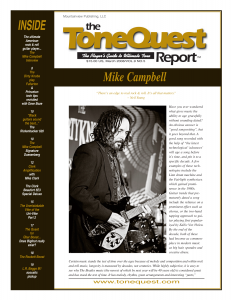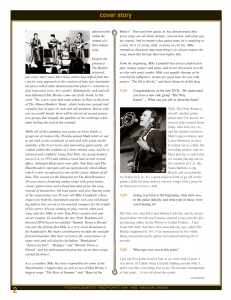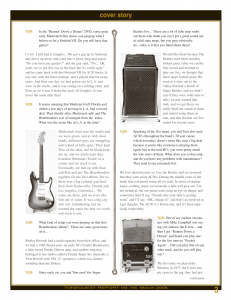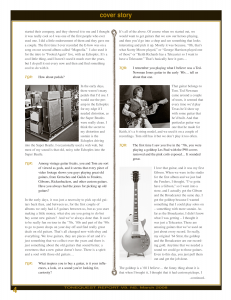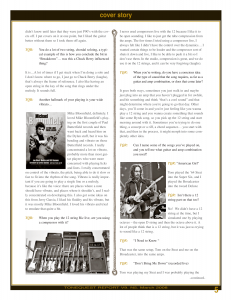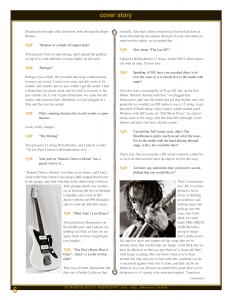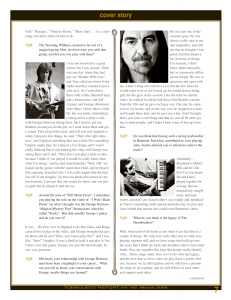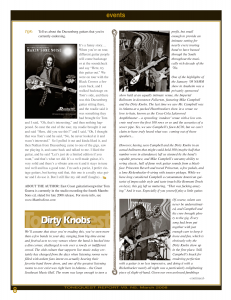Mike Campbell
by Tom Guerra
ToneQuest Report - March 2008
Have you ever wondered what gives music the ability to age gracefully without sounding dated? An obvious answer is "good songwriting," but it goes beyond that. A good song recorded with the help of the latest technology 'advances' will age a song before its time, and pin it to a specific decade. A few examples of these technologies include the Linn drum machine and the Fairlight synthesizer, which gained prominence in the 1980s. Guitar trends that prematurely dated a song include the reliance on a prominent effect such as chorus, or the two-hand approach to guitar playing first popularized by Eddie Van Halen. By the end of the decade, both of these had become as commonplace in modern music as big hair, spandex, and cocaine abuse.
Certain music stands the test of time because of melody and composition and within rock and roll music, longevity is measured by decades, not centuries. While highly subjective, it is easy to see why The Beatles music (the newest of which by next year will be 40 years old) is considered great and has stood the test of time. It has melody, rhythm, great arrangement and interesting "parts," played mostly within the context of a three minute song.
Despite the greatness The Beatles achieved, just a few short years later many artists had shifted from this concise song approach to the creation of long epic instrumental pieces which often demonstrated the player's virtuosity to play long solos (wow, he's good!). Although the rock and roll that influenced The Beatles came out of the South, by the early '70s, a new wave had come ashore in Dixie in the form of The Allman Brothers' Band, which broke new ground and certainly has its place in rock and roll greatness. But as with any successful bands, there will be dozens of second generation groups that magnify the qualities of the archetype while often lacking the soul of the original.
While all of this jamming was going on down South, a group out of Gainesville, Florida named Mudcrutch set out to get back to the essentials of rock and roll; great catchy melodies with clever lyrics and interesting guitar parts, all crafted within the confines of a three minute song. Led by a talented and confident Tom Petty, the group headed out to L.A. in 1974 and within a week had several record offers. Although Mudcrutch soon split, Tom Petty and The Heartbreakers emerged with an eponymously titled album which is now recognized as one of the classic debuts of all time. This record set the blueprint for The Heartbreakers' 30-year career, featuring strong songs with great hooks, classic guitar tones and a band that played for the song instead of themselves. On lead guitar and also sharing some of the songwriting was 26 year old Mike Campbell, whose respect for both his instrument and the rock and roll founding fathers has served as his musical compass for the length of his career. Always seeming to play exactly what each song calls for, Mike is truly Tom Petty's perfect foil and secret weapon. In watching the new Peter Bogdanovich directed DVD boxed set entitled "Runnin' Down a Dream," one gets the feeling that Mike is a very loyal lieutenant to his bandleader. His many contributions include the straight-forward melodies that have served as the cornerstones of many rock and roll classics including "Breakdown," "American Girl," "Refugee," and "Runnin' Down a Dream" and his understated playing has given these songs eternal freshness.
As a co-author, Mike has been responsible for some of the Heartbreakers' biggest hits, as well as two of Don Henley's biggest songs "The Boys of Summer" and "Heart of the Matter." Time and time again, he has demonstrated that great songs are all about melody, construction, and great guitar sounds. And no matter what guitar tones he is applying to a tune, be it 12 string, slide, acoustic, or electric, Mike reminds us that most important thing is to always respect the song, much like George Harrison before him.
From the beginning, Mike Campbell has always preferred to play vintage guitars and amps, and in our discussion he tells us why with great candor. Mike was equally sharing as he covered his influences, recipes for good tones, his new side project "The Dirty Knobs," and those things he holds dear.
TQR: Congratulations on the new DVD...We understand you have a new side group "The Dirty Knobs"...What can you tell us about the band?
Well, The Dirty Knobs is myself, another guitar player that I've known for several years named Jason Sinay who lives in L.A., and the rhythm section is Matt Laug on drums, and Lance Morrison on bass. It started out as a little fun recording project, and we liked playing so much that we started playing out on the outskirts of L.A., like Santa Barbara, Long Beach, and occasionally we'll play in L.A. It's a great place to kind of go off on the guitar a little more and try out new songs with a great little band and we have a ball.
TQR: Going way back to the beginning, what drew you to the guitar initially, and what type of music were you listening to?
My Dad was a big Elvis and Johnny Cash fan, and he always played those records and I always seemed to key into the guitar playing, either Scotty Moore or Luther Perkins... I just loved that stuff. And then, like most kids my age, when The Beatles happened in '64, I was mesmerized by the whole thing, and picked up the guitar and started learning off of records.
TQR: What age were you at this point?
I got my first guitar kind of late as we were kind of poor; I was about 16 I think when I started fiddling around with it, and it was like everything else in my life became unimportant at that point... it was all about the guitar.
TQR: In the "Runnin' Down a Dream" DVD, some great early Mudcrutch film shows you playing what I believe to be a Firebird VII. Do you still have that guitar?
I wish I still had it (laughs)... We got a gig up in Alabama and drove up there, and went into a pawn shop and asked "Do you have any guitars?" and the guy said, "No... Oh, yeah, we've got this one in the back, but it's really ugly," and he came back with this Firebird VII for $120 bucks. It was red, with the three pickups, and I played that for many years. And then one day, we had gotten out to L.A. and were in the studio, and it was sitting on a folding chair, and Tom sat on it and it broke the neck off (laughs). It was never the same after that!
TQR: It seems amazing that Mudcrutch left Florida and within a few days of arriving in L.A. had a record deal. Then shortly after, Mudcrutch split and The Heartbreakers sort of emerged from the ashes ... What was the scene like in L.A. at the time?
Mudcrutch went into the studio and we were green, and as with most bands, different guys are struggling and it kind of falls apart. They kept Tom on the deal, and he kinda kept me on, and we kinda kept (keyboardist) Benmont (Tench) in a corner and we stuck it out. Eventually, we met up with Stan and Ron and got The Heartbreakers together for the first albu,. For us, there was a big cultural gap back then from Gainesville, Florida, and Los Angeles, California... We came out there, and we were like fish out of water. It was a big city and very intimidating, but we learned the ropes the best we could and stuck it out.
TQR: What kind of setup you were playing on that first Heartbreakers album? There are some great tones on it...
Shelter Records had a studio upstairs from their office, and we had a 1964 Stratocaster, an early 50's Fender Broadcaster, a little tweed Fender Deluxe amp, and another amp that belonged to the studio called a Fender Super Six (basically a Twin Reverb with SIX 12" speakers), which was cleaner sounding than the Deluxe.
TQR: Since early on, you and Tom used Vox Super Beatles live... There are a lot of tube amp snobs out there who think you can't get a good sound out of solid state amps, but you guys obviously do... what is it that you like about them?
We did like them because The Beatles used them and they looked great. After we cut that first record and decided to play out live, we thought that those amps looked great. We went to a store in the Valley that had a bunch of Super Beatles, and we didn't care if they were solid state or tube, we just wanted that look, and we got them, we really liked the sound of them and started using them on tour, and that became our live sound for several years.
TQR: Speaking of the Vox amps, you and Tom also used AC30's throughout the band's 30 year career, which nowadays doesn't seem like much a big deal because it seems like everyone is plaing them again, but in the mid-80's, you were pretty much the sole users of them. What drew you to that amp, and do you have any problems with maintenance? They tend to run extremely hot.
We love them because we love the Beatles and we assumed that they were using AC30s. During the middle years of the band, that was pretty much all we used. In terms of maintenance, nothing major, occasionally a tube will give out. I'm not technical, but our guitar techs keep an eye of things, and sometimes they'll say "Sounds like your tube is getting weak" and I'll say, "OK, change it!" and that's as involved as I get (laughs). My AC30 is a brown one, and it's been especially roadworthy.
TQR: One of my earliest encounters with Mike Campbell was seeing you endorse the E-bow... and then I got "Runnin" Down a Dream" and heard you play one for the live intro to "Fooled Again"... Did you play that on any other track, and do you still play one?
The first time we played the Whiskey in 1977, the E-bow people came to the gig, they had just started their company, and they showed it to me and I thought it was really cool so I was one of the first people who ever used one. I did a little endorsement of them and they gave me a couple. The first time I ever recorded the E-bow was on a song on our second album called "Magnolia." I also used it for the intro to "Fooled Again" live, with an Echoplex. It's a cool little thing, and I haven't used it much over the years, but I do pull it out every now and then and find something cool to do with it.
TQR: How about pedals?
In the early days, there weren't many pedals that I'd use. I would use the preamp in the Echoplex for my edge if I needed distortion, as the Super Beatles were really clean. I think the secret to my distortion and sustain is the Echoplex driving into the Super Beatle. I occasionally used a wah wah, but most of my sound is that old, noisy tube Echoplex into the Super Beatle.
TQR: Among vintage guitar freaks, you and Tom are sort of viewed as gods, and it seems that every piece of video footage shows you guys playing great old guitars, from Gretsches and Guilds to Fenders, Gibsons, Rickenbackers, and other custom guitars. Have you always had the jones for picking up old guitars?
In the early days, it was just a necessity to pick up old guitars back then, and between us, for the first couple of albums we only had 4-5 guitars between us, but as you start making a little money, what else are you going to do but buy some new guitars? And we've always done that. It used to be really fun on tour in the '70s, '80s and part of the '90s to go to pawn shops on your day off and find really great deals on old guitars. That's all changed now with ebay and everything. We love guitars, they are pieces of art and it's just something that we collect over the years and there is just something about the old guitars that sound better, a sweetness that a new guitar doesn't have. There is a spirit and a soul with those old guitars...
TQR: What inspires you to buy a guitar, is it your influences, a look, or a sound you're looking for, curiosity?
It's all of the above. Of course when we started out, we would want to get guitars that we saw our heroes playing, and then you'd go into a shop and see something that looks interesting and pick it up. Mostly it was because, "Oh, that's what Scotty Moore played" or "George Harrison played one of those" or "Keith Richards has a Telecaster so I want to have a Telecaster." That's basically how it goes...
TQR: I remember you playing what I believe was a Ted Newman Jones guitar in the early '80s... tell us about that one.
That guitar belongs to Tom. Ted Newman came around a couple of tours, it seemed that every time we'd play Texas he'd show up with some guitar that he'd built. And that particular guitar was one that he made for Keith, it's a 6 string model, and we used it on a couple of recordings. Tom still has it but we don't play it too often.
TQR: The first time I saw you live in the '70s, you were playing a goldtop Les Paul with the P90 covers removed and the pink coils exposed... It sounded great.
I love that guitar, and it was my first Gibson. When we were in the studio for the first album and we just had the Fenders, I thought, "I've gotta have a Gibson," so I went into a store, and I actually got the Gibson and the Broadcaster the same day. I got the goldtop because I wanted something that I could play solos on -- something with more sustain. As far as the Broadcaster, I didn't know what I was getting -- I thought it was just a Telecaster. These are amazing guitars that we've used on just about every record. So, really, my original '64 Strat, the goldtop and the Broadcaster are our recording gold. Anytime that we needed a sound we could go to those guitars. Even to this day, you just pull them out and get the job done.
The goldtop is a '68 I believe... the funny thing about it is that when I bought it, I thought that it had custom pickups, I didn't know until later that they were just P90s with the covers off. I put covers on it at one point, but I liked the guitar better without them so I took them off again.
TQR: You do a lot of two string, chordal soloing, a typical example of this was how you conclude the bit in "Breakdown"... was this a Chuck Berry influenced thing?
It is... A lot of times if I get stuck when I'm doing a solo and I don't know where to do, I just go Chuck Berry (laughs), that's always the frame of reference. I also like having an open string in the key of the song that rings under the melody. It sounds full.
TQR: Another hallmark of your playing is your wide vibrato...
Mike Bloomfield, definitely. I loved Mike Bloomfield's playing on the first couple of Paul Butterfield records and then went back and heard him on the Dylan stuff, but it was his bending and vibrato on those Butterfield records. I really concentrated a lot on vibrato, probably more than most guitar players who were more concerned with playing licks and lines. I really concentrated on control of the vibrato, the pitch, being able to do it slow or fast to fit into the rhythm of the song. Vibrato is really important if you are going to play a single line or a melody, because it's like the voice: there are places where a note should have vibrato, and places where it shouldn't, and I really concentrated on developing this. I also got some ideas on this from Jerry Garcia, I liked his fluidity and his vibrato and tried to emulate that quite a bit.
TQR: When you play the 12 string Ric live, are you using a compressor with it?
I never used compressors live with the 12 because I like it to be open sounding. I like to get the tube compression from the amps. The few times I tried using a compressor live, I always felt like I didn't have the control over the dynamics... I wanted certain things to be louder and the compressor sort of shuts it down and live, I like to be able to push it a bit so I don't use them. In the studio, compression is great, and we do use it on the 12 strings, and it can be very forgiving (laughs).
TQR: When you're writing, do you have a conscious idea of the type of sound that the song requires, as far as a guitar or amp combination, or does that come later?
It goes both ways, sometimes you walk in and maybe just plug into an amp that you haven't plugged in for awhile, and hit something and think "that's a cool sound" and that might determine where you're going to go that day. Other days, you'll come in and you're just feeling like you wanna play a 12 string and you wanna create something that sounds like some Byrds songs, so you pick up the 12 string and start messing around with it. Sometimes you're trying to do one thing, a concept or a riff, a chord sequence... you start with that, and then in the process, it might morph into some completely other idea.
TQR: Can I name some of the songs you played on, and you tell me what guitar and amp combination you used?
TQR: "American Girl"
Tom played the '64 Strat into the Super Six, and I played the Broadcaster into the tweed Deluxe.
TQR: Isn't there a 12 string part on that too?
No! We didn't have a 12 string at the time, but I simulated one by playing octaves -- the open D string and then the octave above it. A lot of people think that is a 12 string, but it was just us trying to sound like a 12 string.
TQR: "I Need To Know"
That was the same setup, Tom on the Strat and me on the Broadcaster, into the same amps.
TQR: "Don't Bring Me Down" (recorded live)
Tom was playing my Strat and I was probably playing the Broadcaster through a Rat distortion, both through the Super Beatles.
TQR: Shadow of a Doubt (Complex Kid)
Tom played a Tele in open tuning, and I played the goldtop on top of it, with different voicings higher up the neck.
TQR: "Refugee"
Refugee was a bitch. We recorded that song a million times trying to get a tone. I tried every amp, and this went on for months and months and we just couldn't get the sound. I had a demo that was pretty good, and we tried to recreate it, but just couldn't do it. Out of pure frustration, we came into the studio, and someone had a Marshall, so I just plugged in a Tele and that was the sound.
TQR: That's amazing because the record sounds so spontaneous...
Lucky really (laughs).
TQR: "The Waiting"
Tom played a 12 string Rickenbacker, and I played a white '70s Les Paul Custom with humbuckers in it...
TQR: Your part on "Runnin' Down a Dream" has a gnarly tone to it...
"Runnin' Down a Dream" was done at my house, and I had a setup at the time where I was using a little Ampeg Rocket out in the garage, and wide with that in the studio I had a Groove Tube preamp which was overdriven, so between the two we blended it together, and I used an SG Junior with the one P90 through it and we came up with that sound.
TQR: "Mary Jane's Last Dance"
Tom played my Broadcaster on the rhythm part, and I played my goldtop Les Paul, so here we are agan, back to those original guitars (laughs).
TQR: "You Don't Know How It Feels"... there's a Leslie on that, right?
That was a Fender Jazzmaster and that was a Fender Leslie on that. Actually, Tom hadf a demo of that track that he had done at home that had the Jazzmaster through a Leslie, and when we went into the studio, we recreated that.
TQR: How about "The Last DJ"?
I played a Rickenbacker 12 string, maybe D/I'd (direct injected) with an amp, I'm not sure.
TQR: Speaking of D/I, have you recorded direct a lot over the years or is it mostly live in the studio with amps?
Over the years, occasionally we'll do D/I, like on the first album "Rockin' Around With You," we plugged that Stratocaster right into the board and got that rhythm tone, but generally we wouldn't go D/I unless it was a 12 string, to get that kind of Byrds thing with a limiter, which sounds good. Working with Jeff Lynne on "Full Moon Fever," we started doing some of the songs with the Strat D/I'd through a Urei limiter, and that's the basic rhythm sound.
TQR: Up until the Jeff Lynne years, didn't The Heartbreakers pretty much record all of the tunes live in the studio with the band playing through amps, with a few overdubs later?
That's true, but occasionally a D/I sound would be called for so we'd do that and also have an amp as well in the song.
TQR: Are there any milestones that you haven't accomplished that you would like to?
That's a hard question. We've accomplished a lot in terms of building an audience, and writing songs that hold up over the years, but I still think we could make THE GREAT ALBUM with a group of songs that's really powerful, and live up to and surpass all the songs that we've already done, that would make be happy. I still think that we have an album in us that can top that we've done and that's what keeps us going. But you know, when you've been around this long and you've had some hits, anything you do is measured against what you've done, and that can be an albatross in a way, because no matter how good what you're doing now is, it's going to be measured against "American Girl," "Refugee," "Need To Know," "Mary Jane"... it's a challenge, but that's what I'd like to do.
TQR: The Traveling Wilburys seemed to be sort of a magical group. How involved were you with that group, and did you ever play with them?
I was not involved to a great extent, but I was around. There was one day, when they had just cut "Handle With Care," and Tom called me down to the studio and they wanted to put a solo on it. So I went down there with a little Marshall amp and a Stratocaster, and Jeff (Lynne) and George (Harrison) were there. I knew them a little bit, but was pretty intimidated, coming down to play a solo with George Harrison sitting there, but I tried to put my blinders on and just do the job, so I went down there and got a sound. They played the track, and Jeff was real supportive when I played a few things, he said, "That's the right direction," and I played something that was a little like something Clapton might play. So I played a few things and I wasn't really thinking that it was helping the song, and George was sitting there and I said, "Why don't you play a slide on this, because I think if you played it would be really better than what I'm doing," and he said (nonchalantly) "Well OK," he picked up the guitar with the sound that I had, and he played that amazing, beautiful solo. I was really happy that the heat was off me (laughs). So that was about (the extent of) my involvement, I just got that one sound for them, and was just so glad that he played it and not me...
TQR: Around the time of "Full Moon Fever," I remember you playing the solo on the video of "I Won't Back Down" on what I thought was the George Harrison "Magical Mystery Tour" Stratocaster, which he called "Rocky." Was that actually George's guitar and do you own it?
It was... We flew over to England to do that video, and Ringo came down to play in the video, and George brought that guitar down and he said, "Here, you wanna play this?" and I was like , "Sure!" (laughs). It was a thrill to hold it and play it, but I don't own that guitar. George was just like that though, he was very generous.
TQR: Obviously your relationship with George Harrison must have been a highlight to your career... What can you tell us about your conversations with George, maybe things you learned?
He was just one of the sweetest guys, he was always really nice to me and supportive, and told me that he thought I was good, and that meant a lot. In terms of things I've learned, I don't know about musically, but as a person he affected me deeply. He was so generous and open with me. I didn't hang out with him a lot, but a few times he would come over or we'd meet up, he would always bring gifts for the guys at the sessions. Like the time we did the video, he walked in and he had these little Beatles watches from the '60s and he gave each guy one. One day, he came over to my house, and on the way over he stopped at a store and bought these hats, and he gave me a hat. And I thought, that's just such a cool thing and that we can all be more giving to other people, and I hope I took some of that up from him.
TQR: Do you think that having such a strong keyboardist in Benmont Tench has contributed to your playing style, maybe allowed you to add more color to the tracks?
Absolutely... Benmont is AMAZING and he's the best I've ever heard. He and I have played together for so long, that we instinctively complement, and interweave, and don't get in each other's way tonally and melodically. There's something really special about the way we play and I don't think that anyone else could cover Benmont's shoes.
TQR: What do you think is the legacy of The Heartbreakers?
Well, what kind of hit home to me when I saw the film is a couple of things. We truly love each other and we truly love playing together still, and we have songs that hold up over the years that I think are head and shoulders above most other bands' that stay together this long that people really identify with... Those songs really have a lot to do with our legacy, and the love that we have when we play them is pretty obvious, because we're still together and we still have a passion for what we do together, and we still believe in each other and support each other.
TQR: Tell us about the Duesenburg guitars that you're currently endorsing.
It's a funny story... When you're on tour, different guitar people will come backstage or at the soundcheck and say, "Here, try this guitar out." We were on your with the Black Crowes a few years back, and I walked backstage on Tom's side, and there was this Duesenberg guitar sitting there, and the roadie said it was something they had brought for Tom and I said, "Oh, that's interesting," and then nothing happened. So near the end of the tour, my roadie brought it out and said, "Here, did you see this?" and I said, "Oh, I thought that was Tom's" and he said, "No, he never looked at it and wasn't interested." So I pulled it out and kinda liked it, and then Nathan from Duesenberg came to one of the gigs, saw me playing it, and came back and talked to me. I liked the guitar, and he said "Let's just do a limited edition if you want," and that's what we did. It's a well made guitar, it's very solid and there's a vibrato arm on it and it stays in tune real well and has a good tone. I'm such a purist, I prefer vintage guitars, but having said that, this one is a really nice guitar and I do use it. But I still like my old stuff (laughs)...
The Dirty Knobs
ToneQuest Report -- March 2008
We'll assume that since you're reading this, you've seen more than a few bands in your day, ranging from big-time arena and festival acts to cozy venues where the band is backed into a dim corner, challenged to win over a rowdy or indifferent crowd. The club culture that supports live music today certainly has changed from the days when listening rooms were filled with ardent fans intent on actually hearing their favorite band throw down, and one of the greatest listening rooms to ever exist was right here in Atlanta -- the Great Southwest Music Hall. The room was large enough to turn a profit, but small enough to provide an intimate setting for nearly every touring band to have bussed through the South throughout the musically rich decade of the '70s.
One of the highlights of the January '08 NAMM show in Anaheim was a privately sponsored show held at an equally intimate venue, the Imperial Ballroom in downtown Fullerton, featuring Mike Campbell and the Dirty Knobs. The last time we saw Mr. Campbell was in Atlanta at a packed Heartbreakers show in a venue we love to hate, known as the Coca-Cola Lakewood Amphitheater -- a sprawling "outdoor" venue with a low concrete roof over the first 100 rows or so and the acoustics of a sewer pipe. Yes, we saw Campbell's fawn AC30, but we can't claim to have truly heard what was coming out of those speakers...
However, having seen Campbell and the Dirty Knobs in an actual ballroom that might could hold 300 (maybe half that number were in attendance) left us stunned by the band's capable presence, and Mike Campbell's uncanny ability to wring classic, hall of fame rock guitar sounds from a black-face Princeton Reverb and tweed Princeton, a few pedals, and a lone Rickenbacker 6-string with toaster pickups. While we have long considered Campbell a consummate American guitarist of impeccable style and taste (much like Benmont Tench on keys), this gig left us muttering, "That was fucking amazing." And it was. Especially if you yourself play a little guitar.
Of course, talent can never be underestimated, and Campbell and his crew brought plenty to the gig. Every song had been put together with just enough care to keep it loose and fun, which is obviously why the Dirty Knobs show up in the first place. Still, Campbell's knack for rendering perfection with a guitar is no less impressive, and doing it with a Rickenbacker nearly all night was particularly enlightening piece of slight-of-hand. Given our own awkward fumblings with Rickenbackers over the years, we felt all the more humbled.

